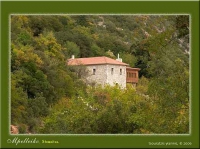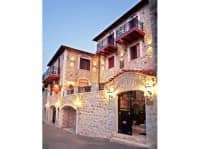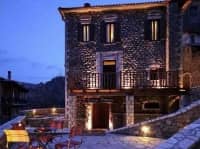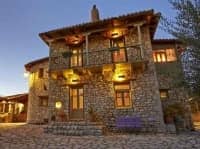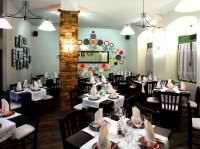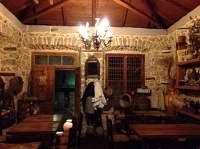Sightseeing in Arcadia
Arcadia, the largest prefecture in the Peloponnese, is one of the most characteristic examples of the variety and diversity that characterize the Greek landscape and the cultural, historical and folk heritage that we encounter in every corner of the Greek world.
Apart from the best known and most prominent tourist destinations and attractions, we want to use the web pages of Exploring Greece to introduce and bring close to you places that are less known or unknown to most people--places we believe it is worthwhile to discover.
From Lykosoura, the first city that saw the sun, oldest of all the cities on land and islands, as Pausanias wrote in the Arkadika [...πόλεων δέ, ὁπόσας ἐπὶ τῇ ἠπείρῳ ἔδειξε γῆ καὶ ἐν νήσοις, Λυκόσουρά ἐστι πρεσβυτάτη, καὶ ταύτην εἶδεν ὁ ἥλιος πρώτην...], past the snowy fir-covered slopes of Mainalo with the ski resort in Ostrakina, to the historic Tripolitsa, whose conquest was decisive for the War of Independence, and finally to the clear blue, quiet, unexplored shores of Kynouria that are washed by the waters of the Myrtoan Sea, Arcadia looks like a giant mosaic, with every piece unique, all together forming a harmonious whole.
Arcadia includes towns such as the beautiful, historic Astros in Kynouria, with the picturesque beach full of life that is more reminiscent of an island than the mainland; the capital of old Tsakonia, beautiful Leonidio, with the breathtaking view of its red rock above Paliokastro and the little church of Ai-Thanasis; the misunderstood Megalopolis, the great Arcadian town built at the urging of Epameinondas in 370 BC to become the worthy rival of Sparta; and of course the capital of Arcadia, the historic Tripoli, which is also the administrative center of the region.
Arcadia also consists of beautiful villages like Spatharis, with its stone houses and architectural ornament, the elementary school donated by Andreas Syngros, like many of our schools of the early 20th century; the village of Isaris, with the mysterious deserted train station that you might say disappears slowly within the impressive tunnel; Liontari, with the church of Agion Apostolon (the Holy Apostles), one of the greatest examples of ecclesiastical architecture in the Peloponnese; and also cities that no longer exist, such as the forgotten Byzantine castle city of Palaiochora southwest of the Holy Monastery of Agiou Nikolaou Kaltezon (Saint Nicholas of Kaltezes), which once comprised more than 2,000 inhabitants and 300 churches.
We will admire villages that are themselves tourist attractions, with a number of points of interest, including Tropaia, capital city of Gortynia; the neighboring Stavrodromi and Vyziki, with the Akova castle and the Baths of Iraias with their mineral springs; and the cosmopolitan Vytina, with its significant touristic infrastructure and beautiful landscapes for endless walks. Also intriguing are the historic Dimitsana, hometown of National Martyr Grigorios the Fifth, and near it the little known but very beautiful villages of the area, such as Zatouna, place of exile for Mikis Theodorakis and home to his museum, and Vlongos, with its enchanting views of the Ionian Sea, where the simple stone houses have been recommended for the first degree of protection in accordance with EU standards, and slightly below that, [Melissopetra] TID:25325], hometown of our great composer, Dimitris Mitropoulos.
We can visit the villages of stone masons, such as Lagkadia, with its beautiful stone buildings, and Pournaria, the "entrance gate," coming from Daphni, to the beautiful artificial Lake of Ladonas and the villages of "Pera Meria." Close to Lagkadia, we see Lefkochori, with the hermitage of Ai-Giorgi (Saint George) and beyond that, the villages of Touthoa and Fouskari, with the three petrogefira (stone bridges) over the Touthoa River. Higher up, we reach the village of Aetorrachi; the Greek name means "the eagle's ridge," and the setting of the village justifies it, with its wonderful views (as far as Zakynthos on clear days) from the nicely landscaped, stone tiled courtyard of the central church of Metamorphosis tou Sotiros (Transfiguration of the Savior). Wild beauty surrounds it, with the Touthoa Gorge to the south and the Goura Gully to the north; here we find rough, longer trails, and the seven-story Giannikoulia Cave.
A little farther north, we see Kalliani, a village rich in natural and cultural attractions such as the half-ruined stone remnants of the first primary school of the village. Built in 1859, it is one of the oldest schools in the area.
There are little-known villages in western Gortynia such as Elaia, with its many natural beauties, and its neighbor Erymanthos, at the farthest edge of Arcadia before we move on to South Ileia and the city of Folois. Higher up, we find Chora, with its historic church of Agios (Saint) Athanasios (where the wooden iconostasis is "adorned" with holes from the bullets with which the Germans executed eleven villagers within the church on August 23, 1943), and just outside Chora, the Moni Kapelis (Kapelis Monastery) and the Gorge of Erymanthos with the pournogefyro (morning bridge), which was constructed in 1718.
The forgotten villages of Pera Meria to the north and west above the Lake of Ladonas feature little known beauties, such as the lakeside Mouria, the mountainous and isolated Xirokaritaina, Dimitra, and the beautiful Ladonas Gorge, where a path through the gorge reaches the dam of the lake.
In Vachlia we can see ancient Thaleiada and the Moni tis Agias Paraskevis (Monastery of Saint Paraskevi), while in Pera Vachlia we can visit the springs of Lesinitsa and the Panagia ton Vrachon (Virgin of the Rocks).
We can explore the country village of Kontovazaina with its four neighborhoods, and above it on Mount Afrodisio, the sanctuary of Aphrodite of Erykinis and the chapel of Agios Petros (Saint Peter); to the northwest, we find Velimachi with the church of the Analypsi (Ascension) on top of Mount Afrodisio. We can see Vydiaki, with its ancient wall, and Monastiraki, with the tower of Ali-Farmaki and the bust of the old man of Moria. Across from Vydiaki, isolated on the south side of the lake, we can gaze at Pteria and Boularii, and a little farther south, we find Galatas and Perdikoneri, with the half destroyed towers of the castle of the barony of Akova facing east.
Other villages are near well-known places and very rich in points of interest, yet are visited infrequently. One example is Nymphasia, only 3 km north of Vytina, with many beautiful sights: the Moni Kernitsa (Kernitsa Monastery), the bridge of Tzavaraina over the Mylaontas River, the hermitage of Sfyrida, the trails through the forest, and the stone fountains. Just north of Nymphasia, we can visit Kamenitsa, with the Neolithic cave and the hermitage of the Ascension, which can be reached after crossing the Mylaontas River.
From Kamenitsa, the road climbs northwest toward the villages of Prasino and Agridi, with the church of Agia Triada (the Holy Trinity) (1865) and its impressive icon screen, and from there it continues west to the slopes of Drakovouni (which means Dragon Mountain), toward Theoktisto and Drakovouni, site of the historic 1944 battle of Glogova against the Germans, to reach the plain of Dara, with the old Venetian tower, and above, the village of Dara, stretching out amphitheatrically on the slopes of Saita.
At 1,250 m, Magouliana is the highest inhabited village in the Peloponnese. Above it, with endless views of every part of the Peloponnese, the Frankish Argyrokastro (Silver Castle) stands tall at 1,450 m. A few kilometers northwest of Magouliana, Valtesiniko, one of the most beautiful villages in Gortynia, has a substantial touristic infrastructure. Traditional houses, churches, and trails provide an ensemble that will satisfy the most discerning traveler.
It is worth visiting the villages of Mainalo, with its fir-covered slopes, such as the beautiful Alonistaina, hometown of the mother of Theodoros Kolokotronis, Zampia Kotsaki; Chrysovitsi, with the ekklisia tis Koimisis (Church of the Dormition) and the image of the Virgin Mary where Kolokotronis prayed; the village of Mainalo, with its stone houses and fountains and the [Forest History Museum of Mainalo][TID:23300], as well as the ruins from the excavation of the temple of Artemis Lykoatida (although recently it was believed that this was excavated in Arachamites).
From the north and east, we can visit historic Vlacherna, with the monastiri tis Panagias tis Eleousas (Monastery of the Merciful Virgin) and the Castle of Bezeniko above the cave of the Virgin Mary of Katafygiotissa, as well as the tomb of Greek Revolutionary War fighter Alexis Nikolaous, who is also known as Levidiotis. The large village of Levidi is nearby, with its Byzantine church of Kimisis tis Theotokou (Dormition of the Virgin Mary), which was built in the 11th century on the foundations of the sacred temple of Artemis Ymnias. In Kapsia we can see a gorgeous cave and ancient cart roads, with ruts from the wheels of wagons that passed along the ancient road from Mantinea to Megalopolis.
Stemnitsa, which some call the most beautiful Arcadian village, is home to the historic Moni tis Chrysopigis (Monastery of Chrysopigi, which was founded in 1443 and was the meeting place for the first Peloponnesian Senate. The village also contributed to the development of the craft of metalwork, which continues to be taught there today at the public school of Silver and Goldsmiths.
In the vicinity of the villages of Stemnitsa and Dimitsana, there are less well known but beautiful places worth visiting such as Zygovitsi, with the monument of the body of the Immortals and the Church of the Transfiguration of the Savior with the chandelier which Kolokotronis brought as loot from the seraglio of Tripolitsa; Palaiochori, where the followers of Kolokotronis and the notables of the village decided to participate in the struggle for independence during their meeting under the plane tree of Agion Anargyron; Lousio (at the Kontos Bridge, built in 1864) and its gorge, with the beautiful getaways; and the exceptionally well cared for Elliniko, with the traditional wells at its entrance.
A few kilometers east of Elliniko, after crossing the Lousio River on the Kokkori Bridge into Ancient Gortyna, we enter Atsicholos, with the ruins of the acropolis of ancient Gortynos and the Atsicholitiko Bridge with its large, pointy, Arabian style arch, from which rafters continue their journey to the Koukou Bridge on the Alfeios River, 5 km south of Vlachorrapti) (now more commonly known as Maratha). We can visit the remains of the ancient walls of the acropolis of the small town of ancient Maratha on the hill of Ai-Nikola as well as the post-Byzantine church of Agios (Saint) Dimitrios.
Continuing south, we visit the beautiful villages on the slopes of Parnonas, such as Agios Petros, with the impressive tower of Trikaliti, Agios Ioannis, with the neighboring castle of Oria, Kastanitsa, with the impressive chestnut forest, Sitaina with the Loulougka Gorge, Platanos, with the waterfalls of Lepida, Prastos, the old historic capital of Tsakonia before the fury of devastation brought by Ibrahim, who also ravaged the town's cathedral (which honored the Virgin Mary), and finally mountainous Korakovouni, with the castle of Artikainas, whose historical details are obscure.
And above these, the charming Parnonas with the Agiolia Plateau and the Sitaina Forest, which has been designated a natural monument. With gorgeous forests of fir, walnut, pine, and cedar, and many species of medicinal and aromatic plants, Parnonas has been deemed, after Olympos, the Greek mountain richest in herbs.
The enchanting Kastritochoria includes seven villages, Kastri, Elatos, Karatoula, Mesorrachi, Oria, Nea Chora and Perdikovrysi, all built close to each other on the slopes of Parthenios and Zavitsa; the most important of these is Kastri, which was previously known as Agios Nikolaos. The moni tou Prodromou (monastery of the Baptist) is especially notable, built into the rock across from the rock of Kotrona in Perdikovrysi, above the bed of the Tanos River. And before we arrive at Agios Nikolaos, we can see beautiful Ano Doliana, where townspeople led by Nikitara barricaded themselves inside the home of Christofili on May 18, 1821 and chased the Turks away.
The villages of Falaisia include historic Liontari, with its castle, which in Byzantine times evolved into the second most important city of the domain of Mystras, and the church of [Agion Apostolon (the Holy Apostles)][TID:25612 ], one of the greatest examples of ecclesiastical architecture in the Peloponnese; Potamia, with the Moni Panagias Boura (Convent of the Virgin Mary of Boura) and the hermitages of Agios (Saint) Nikonas and of the Life-Giving Springs; and Kamara with the Panagia ton Vrachon (Virgin of the Rocks) and the castle on the hill of Ai-Thanasis.
Between Tourkoleka, the hometown of Nikitara, and Cheirades is the Castle of Oria in Gardiki, where the steep southern hillside was filled with the corpses of Greeks slaughtered by the army of Mehmed II the Conqueror. Nearby is Ano Giannaious with the historic monastery of Rekitsa, where Papaflessas lived as a monk until 1817, and Kato Giannaious, with the refurbished working water mill. Farther north, we find Skortsinos, with Agios Konstantinos on the hilltop with the Chelmos Castle and both ancient Mycenaean remains and medieval fortifications; heading out of Skortsinos toward Petrina, we will find the source of the Evrotas River.
Many of the villages in Arcadia are closely associated with modern Greek history, and one of the most important of these is Akovos, where there was a famous three-day battle between the army of Ibrahim and the brave youths of Theodoros Kolokotronis on the hill of Drampala starting on June 5, 1825. In Akovos we also find the so-called stone of Kolokotronis with his initials on it (ΘΚ), while just outside the village we can visit the Church of Agia (Saint) Solomoni, which was once the monastery in which Papaflessas ran a secret school.
We see the blue sea from the shores of Tsakonia, from the Arcadian village and farther south, to Tyro, with its early Hellenic ancient Acropolis above the beach, in the picturesque little port of Sampatiki. We can admire this from above, near the little church of Agios Nikolaos ke Agios Fanourios (Saint Nicholas and Saint Fanourios) outside Pragmatefti. The blue sea follows us farther south to Plaka, the seaport of Leonidio, with its beautiful beaches, and Poulithra, with the picturesque chapel of Agios Georgios (Saint George) on the eastern edge of the Gulf.
From Leonidio, moving west and south toward the southeastern slopes of Parnonas, we will encounter beautiful, little-known mountain villages. The most typical is Kosmas, with many hiking trails that invite us to walk; one of them is the path to Kato Ai-Georgi. We will also find Palaiochori with the Moni tou Taxiarchi Mouras (Monastery of the Archangel Mouras), Agios Vasileios with the tower houses, Platanaki with the Paliopanagia and the medieval tower in ancient Glyppia, Tsitalia and the mansions of Peleta, with their beautiful homes and the two windmills on two hilltops. In Peleta we should not forget to see the deepest sinkhole in the Peloponnese, which to date has been explored down to 630 meters.
South of Tripoli, there are numerous villages, each with its own history, such as Neochori, with the historical moni Varson (Varson Monastery), Partheni, with the beautiful train station, Agiorgitika, on the wine routes, with the prehistoric metallurgical furnaces, and slightly to the east the ruined Byzantine city of Mouchli, which was built in 1296 and destroyed in 1460 by the Turks.
We can visit the beautiful Alea, with its impressive neoclassical houses and the magnificent temple of Athina Alea, and immediately afterwards the park of Episkopi, in which we can see impressive remains from many historical epochs. Farther west, we find [Pallantio][TID:23190], from which King Evander of Pallene started out to found ancient Rome; in his honor, the Romans named one of the seven hills of Rome "Palatine."
Moving farther south, on the road to Sparta, we reach Vlachokerasia, a traditional village overgrown with dense vegetation, as well as the plane, chestnut, walnut and cherry trees of the Skyritida Park, the lifetime project of Tasos Stephanou, to arrive outside of Agia Varvara at the bridge over the Evrotas River, after the deserted Achouri settlement.
If we search for them, we can also find villages that no longer exist because they disappeared or were abandoned, such as Anthochori outside Megalopolis, which was engulfed by the power company's machinery for lignite mining, or old Makrysi, east of Megalopolis, which was ravaged by the earthquake of 1960, and old Ekklisoula, north of the city, which its residents fled in 1960 due to landslides.
Farther north of Megalopolis, 4 km from the Lake of Mantineia, we find the mountainous, deserted Elatos, with the fallen stone houses and the beautiful church of Agia Paraskevi (Saint Friday). From here, the road continues to the plateau of Feneos. Farther east, in North Kynouria, opposite Kato Doliana, we reach Kaminari, where the church of Agios Antonios (Saint Anthony) is the only surviving building.
Ornaments of traditional architecture such as stone arched bridges crown the banks of the Alfeios River, the Erymanthos River, and the Lousios River. There are bridges that are known, like the five-arched bridge over the Alfeios in Karytaina, the most important example of Byzantine bridge architecture that survives today, but also others that are unknown, such as the beautiful bridge of Domokos on the Erymanthos, north of Vydiaki on the border with Ileia, a protected monument built in 1870. Beautiful stone fountains will quench our thirst with their cool, crystal clear water, and we will find them in almost every mountain village we visit.
Special charm, architectural excellence and nostalgia "radiate" from the presently deserted stations and railway bridges of the railroad network in the region that once were full of life, providing the main means of transportation for the inhabitants of these villages. Especially noteworthy are the architecturally ornamented stations in Liontari (the old one and the new one), in Megalopolis, in Chrani, in Anemodouri, in Isaris, in Anthochori, in Tripotamo, and in Paradeisia, as well as some railway bridges that are really technical marvels of their time, such as the six-arch railway bridge in Chrani and the one in Anemodouri.
Presently deserted railway stations and bridges were once full of life, providing the main means of transportation for the inhabitants of these villages. Especially noteworthy are the architecturally ornamented stations in Liontari (the old one and the new one), in Megalopolis, in Chrani, in Anemodouri, in Isaris, in Elaiochori, in Partheni, in Kato Asea (3 miles southeast of Asea, birthplace of the great poet Nikos Gatsos), as well as some railway bridges that are really technical marvels of their time, such as the one in Anemodouri, the six-arch railway bridge in Chrani, and the largest in Greece, the impressive eight-arch stone railway bridge in Manaris that was designed by French engineers in the late 19th century.
A visit to Frankish and Byzantine Castles is in itself a pleasant adventure and a unique experience; for example, we might seek out the unknown Castle Orionta above the plateau of Palaiochora and the Karya Monastery, or the Castle of Oria in Gardiki, 7 km from Tourkoleka, where the southern side of the cliff was filled with the corpses of Greeks slaughtered by the army of Mehmed II the Conqueror, or the impregnable Castle of Ai-Giorgi (Saint George) ton Skorton, 4 km outside of Kourounio.
Frankish and Venetian towers still stand half-ruined, remnants of Frankish rule in Greece, such as those in Rousis, Loukas, Palaiopyrgos above the Lake of Ladonas, in beautiful Papari, and between Agios Vasileios and Platanaki, where we find the impressive twelve-meter medieval tower on the site where archaeologists place ancient Glyppia.
Some archaeological sites are very well known, such as the sanctuary of Despina in Lykosoura; the largest ancient theater of its time, with a capacity of 20,000 spectators, in Megalopolis; the sanctuary of Zeus, the most revered in Arcadia, on [Mount Lykaion][TID:23435] (the Arcadian Mount Olympos); Ancient Orchomenos, north of Levidi, capital of Arcadia for 150 years; ancient Mantineia (in Polybius, called the "most ancient and greatest city of Arcadia"); the park of Episkopi; Ancient Gortyna, on the banks of the Lousios River; the archaeological site of Eva in Astros, Kynouria; but also lesser known sites, such as the ancient mountain road known as the Klimaka of Pausanias above the village of Sagkas; the Mycenaean cemetery with more than 100 vaulted tombs and the most ancient necromantic oracle 5 km from Palaiokastro in Sarakini; or ancient Theisoa, with the foundations of the temple of the Great God Zeus in [Karkalou][TID:24655 ] among the firs; and ancient Komi Thaleiada, which is mentioned by Pausanias, in Vachlia.
Monasteries that are important to the Greek cultural and Christian heritage include the Holy Monastery Ioannou tou Prodromou (John the Baptist) above Lousios, from which a beautiful path leads us to the Mones Filosofou tin palaia (Monasteries of the Philosopher, old) and new; the Holy Monastery Kleivokas outside Kontovazaina, built on a sharp rock 200 m high, with 140 steps leading to the church; the historic Monastery of the Virgin Mary of Bouras, dedicated to the Dormition of the Virgin Mary, founded outside Potamia in the 11th century; and the famed Malevi Monastery outside Agios Petros, also dedicated to the Dormition of the Virgin Mary (the myrrh smelling icon of the Virgin is the work of the Apostle Luke).
We can see cloisters or hermitages carved into cliffs, like the cave of the Holy Archangel) between Kourouveli and Olomades; the hermitages of Saint Nikon Metanoeite (the "preacher of repentance" who passed through Potamia in the early 10th century) and of Zoodochou Pigi (the Life Giving Spring) in Potamia; the Panagia ton Vrachon (Virgin of the Rocks) in Pera Vachlia, where you will need to climb 400 meters to admire the church that is built into the rock; and also the Virgin of the Rocks in Kamara (after Kampochori in Falaisia ); the hermitage of the Archangels in beautiful Rafti, wedged into the rock; and built in 1697, the hermitage of Agios Vasileios (Saint Basil) in Loukas, where the view from 920 m toward the lower plains and Loukas, with its surrounding hills, is impressive.
The ekklisaki tis Agias Theodoras (church of Saint Theodora), surrounded by stone walls in the beautiful ravine of Agia Theodora outside Basta, has 17 trees growing on the church walls without visible roots either externally or inside the church. This is one of the most famous attractions in the Peloponnese and in the entire country.
Arcadia has many chapels and churches with a history that reaches back to antiquity, having been built on ancient sacred sites and/or with ancient materials, such as the ruined Psilos Ai-Yiannis (High Saint John) in Isioma Karyon, built on top of the ruins of an ancient temple of Apollo in Parrasia, and the churches of the Virgin Mary of Kamara and Kapsocheirovolousa, below Kastanochori, with materials from ancient Parrasia. Once in Kastanochori, we should be sure to visit to the deserted 12th century monastery of the Virgin Mary of Krampovos.
There are many historic sites in Arcadia, most of them associated with events that took place during the struggle for independence from the Ottoman Empire in 1821, such as the Archaeological Museum of Astros, where the Second Assembly of the Independent Greek State took place in the buildings of the Karytsiotis School in April 1823; the strongholds of Ypsilanti and Kolokotronis in Trikorfa, outside Tripoli; the hill of Drampala, near Akovos, site of a battle between the army of Ibrahim and the young fighters of Kolokotronis (leader of the Greek Independence War) from June 5-7, 1825; the monument to Kolokotronis fighters in Lynos, next to the Moni Aimyalon (Aimyalos Monastery, where a team of six thieves led by Giannis Zorbas (Kolokotronis) met a heroic but tragic death in the 1806; the home of the Kolokotronis family in Limpovisi and the home of Kolokotronis in the castle of Karytaina; the tower of Plapouta in Paloumpa; and the ovens of the revolution (nationalistic bakeries that supplied bread to fighters) in Piana.
Arcadia is full of natural beauties such as flowing rivers like the Alfeios, the Erymanthos, the Lousios, and the Ladonas rivers, as well as lakes, such as the artificial Lake of Ladonas with the public power company's hydroelectric dam and the low-lying old Kyra Bridge below Mygdalia and Pteria, which sometimes rises up and sometimes disappears into the waters of the lake. There are gorges such as the Ladonas Gorge in beautiful Dimitra, the Lousios Gorge in Stemnitsa, and the Loulougka Gorge in Sitaina, with the impressive waterfall and steep cliffside of Zangolis Castle near the Zarmpanitsa Gorge.
Geologic formations such as the cave of Kapsia, one of the top ten Greek caves, can be found next to the sinkholes of the Mantineian valley that drain the waters of the entire plain, which flow into the sea in the region of Lileika at "Anavalos Xiropigadou" (Lileiko mati, or eye). Also interesting is the sinkhole in Peleta, the deepest in the Peloponnese, which to date has been explored down to 630 meters.
We can find many gorgeous beaches washed by the waters of the Myrtoan Sea, some crowded and organized, such as beaches around Xiropigado, Paralia Astros (spread over kilometers of sand below the castle of Zafiropoulos), or Agios Andreas, with the windmill that is slowly disappearing into the sea. But there are also remote, secluded, dreamy beaches like Fokiana, the southernmost beach that is accessible by land in Arcadia, before we move on to Laconia.
Wetlands such as Moustos (Natura 2000) in Meligou provide a rest stop for migratory birds; Moustos also hosts a large variety of birds, fish, and reptiles, as well as caretta caretta turtles. We can admire it from above, from the pine-covered hill at the exit of Meligou (on the side closest to Koutroufa). On the hill, we also find Kastraki and the small church of Agion Apostolon (the Holy Apostles).
Countless peaks, with chapels--usually honoring the Prophet Elias--offer delightful views of the surrounding areas but also require substantial effort to conquer. Some examples are the chapel of the Prophet Elias (or Elijah) on the Tetrazi hilltop in Basta, on [Mount Lykaion][TID:23435], next to the sanctuary of Zeus; in Kosmas, there was an ancient temple dedicated to Maleatis Apollo; and in Pera Melana the local church was built on the ruins of a 6th century BC temple of Apollo Tyrita.
On peaks with castles, we often find small churches built in honor of the patron saint of castles, Ai-Giorgis (Saint George), as on the steep and precipitous Goula Rock above beautiful Nestani, the Moni Gorgoepikoou (Gorgoepikoos Monastery), and Ai Giorgis on the hilltop with the Castle of Skorton outside of Kourounio.
We will introduce you to all of these intriguing places as well as many more well-known and little-known Arcadian attractions in the pages of Exploring Greece.

[TID:23300]: https://www.exploring-greece.gr/en/show/23300 "Forest History Museum of Mainalo " [TID:23190]: https://www.exploring-greece.gr/en/show/23190 "Temple of Cathar Gods - Acropolis of Pallantio " [TID:23435]: https://www.exploring-greece.gr/en/show/23435 "Summit of Mount Lykaion " [TID:23435]: https://www.exploring-greece.gr/en/show/23435 "Summit of Mount Lykaion "


